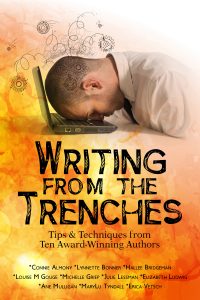by Hallee Bridgeman, @halleeb
In part 1 of this 2 part series, we talked about the three (or five) basic conflicts and seven basic plots in fiction storytelling, and how really good characterization is what will set your story apart.
In my years of writing, I’ve learned that readers want to know your characters. They want to connect with them, to find a way to relate to them. They want to feel their pain and their joy and their love. It’s why readers read. The plots are important, but really only in a way that it creates the circumstances around which the reader connects with the characters.
What does good characterization mean?
I’ll give you a personal example. When a popular young adult series was turned into a movie, my daughter was thrilled. She bought the magazines that contained character interviews, behind-the-scenes images, and snapshots of costumes. I remember her excitement as she poured through the magazines over and over again, waiting for the movie release. We went on opening night, and I watched the joy on her face as this beloved book unfolded in front of her eyes.
After reading several reviews by fans all over the place, all containing great praise for the sets and casting and costumes, I was filled with intense curiosity. I wanted to know what the author had written that would create such a reaction from people worldwide who went to the movie. The sets were fantastical, the costumes extraordinary. What words did she write that produced such images?
I borrowed the books from my daughter and spent a weekend reading them. I enjoyed the first book tremendously, the second okay, and by the end of the third, felt strangely disconnected from the story. I no longer cared what happened or how it would end. After I finished it, I spent the next couple of weeks mulling over my response and why I thought I felt that way. Finally, it occurred to me.
There was a complete absence of faith in the book. It wasn’t just not there, it was like it was stripped completely away. As Christian authors, we know that our souls seek out God, even when we don’t know what we’re seeking. I understand the oppressive regime post-apocalyptic environment in which the series was set; however, there wasn’t even an underground religion or a remembering of what used to be as far as religion goes. There was simply nothing, which isn’t realistic.
Once I realized what was missing, I thought about it further. What happened was, subconsciously, the characters became less real to me. Characters I’d felt invested in in the first book were so two dimensional by the end of the third book that I could no longer find a way in which to relate to them. I no longer cared what happened to them because I didn’t think of them as real people anymore. It didn’t matter how it ended, because they were “just” characters on a page.
THREE DIMENSIONAL CHARACTERS
Any main character and many secondary characters in your story must be three dimensional. What does that mean?
1) PHYSICAL: Where are they in the world? What do they look like? What kind of physical ailments do they live with? What kind of clothes do they wear? What kind of shoes do they like? What mannerisms do they possess?
2) INTELLECTUAL: What do they know? How did they learn it? How do they filter information that comes to them? What kind of special knowledge do they have? What kind of mental deficiencies do they possess? How do their brains process information? What do they do with information they receive?
3) SPIRITUAL/EMOTIONAL: What do they feel? How do they feel it? How are their feelings filtered through spiritual understanding? What do they believe in spiritually? What is their faith? Why is there a lack of faith? How much of their faith affects their processing of the world around them? How much does their faith affect their emotions? What is their history with deep emotional moments in their lives? What deity do they claim? What is the basis of that belief?
With a peripheral character (the hotel bellman, the taxi driver, the waiter), one or two dimensions is usually all you need. Unless the waiter in the restaurant reappears as a new character in this book or maybe later in a series, then knowing that he’s wearing an ill-fitting cheap suit with a mustard stain on the shirt might be all we need to know. We don’t even need to know HOW that stain got there.
However, with main characters and most secondary characters, you need to divulge all three dimensions to the reader in some way or form. In order to do that, you need to KNOW your characters as if you raised them — which, in an odd way, you do.
There are many different ways to do this. One way is to create a character worksheet. You can find a sample of one at my website here: http://www.halleebridgeman.com/wp-content/uploads/2018/08/CHARACTER-WORKSHEET.pdf
There is a lot of information to fill out in a character sketch like what I’ve provided, especially when you’re working in this book right now and know your characters like you know your own kids. However, when you’re writing multiple books in a series, you will be so thankful to yourself if you take the time to fill something like this out. While you may think that your current characters will always have priority in your mind, the fact is they will not. As you go from book to book, your current characters are the most important characters, and what you know you know about the characters from previous books starts to fade away.
I’m a very visual person. I think better when things are laid out for me. Consequently, when I’m working through a character, I do a lot of my work in Pinterest. I create a board for each book, and as I pin images of characters, clothes, tattoos, houses, cars, the character comes vividly to life in my mind.
There is no right or wrong way to sketch out a character. Do it the way that works best for the way your mind works; however, do it. Try to bring the character to life before you try to bring the book to life. MOST of the information you come up with about your character might not make it to the page. That’s okay. It’s important that you know as much about your character as possible, because then what you do bring to the page will be whole and complete, three dimensional, instead of just a shell.
YOU … and an Army of Ten!
TEN-HUT! Gear up for your writing with tried-and-true tips from the trenches. Ten award-winning authors share invaluable tips and secrets they’ve gleaned the hard way, offering a broad range of insights and opinions on the best way to tackle subjects such as the following:
- Plotting Techniques
- Research
- Characterization
- Villains We Love to Hate
- Dynamic Dialogue
- Sigh-Worthy Heroes
- The Right Heroine for the Job
- Hooking Your Reader in the First Chapter
- Scene Endings to Lead Your Readers
- On Creating a Movie Set
- Making your Readers Cry
- Deep POV
- Copyediting your Manuscript
- Indie Publishing vs. Traditional
- Publishing Marketing for Those Who Hate Marketing
At last … a writer’s tool that provides the experience and expertise of ten authors who’ve been on the front lines of publishing and lived to teach about it: Connie Almony, Lynnette Bonner, Hallee Bridgeman, Louise Gouge, Michelle Griep, Julie Lessman, Elizabeth Ludwig, Ane Mulligan, MaryLu Tyndall, and Erica Vetsch.

With more than half a million book sales, Hallee Bridgeman is a best-selling Christian author who writes action-packed romantic suspense focusing on realistic characters who face real world problems. Her work has been described as everything from refreshing to heart-stopping exciting and edgy.
An Army brat turned Floridian, Hallee finally settled in central Kentucky with her family so that she could enjoy the beautiful changing of the seasons. She enjoys the roller-coaster ride thrills that life with a National Guard husband, a college sophomore daughter, and two elementary aged sons delivers.
A prolific writer, when she’s not penning novels, you will find her in the kitchen, which she considers the ‘heart of the home’. Her passion for cooking spurred her to launch a whole food, real food “Parody” cookbook series. In addition to nutritious, Biblically grounded recipes, readers will find that each cookbook also confronts some controversial aspect of secular pop culture.
Hallee is a member of the Published Author Network (PAN) of the Romance Writers of America (RWA) where she serves as a long time board member in the Faith, Hope, & Love chapter. She is a member of the American Christian Fiction Writers (ACFW) and the American Christian Writers (ACW) as well as being a member of Novelists, Inc. (NINC).
Hallee loves coffee, campy action movies, and regular date nights with her husband. Above all else, she loves God with all of her heart, soul, mind, and strength; has been redeemed by the blood of Christ; and relies on the presence of the Holy Spirit to guide her. She prays her work here on earth is a blessing to you and would love to hear from you. You find Hallee on her blog at halleebridgeman.com


